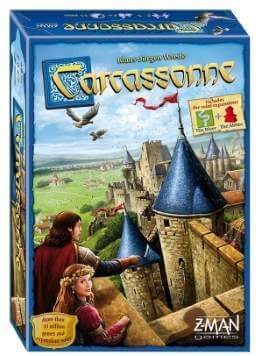Best Multiplayer Board Games for 2 Players
We’ve provided the best of the bunch of board games for 2 people (dedicated 2 player games) and now a forward to that is a collection of Multiplayer Games that Play Out Great with 2 Players.

Imagine if you will…
You arrange a meetup with a few friends for a game night. One of your friends is very dependable and you know for a fact will show up, but the other two not so much. They have a tendency to cancel last minute. As you browse your game shelf to decide which games to bring, you are faced with a challenging dilemma: Which games can you bring that can play 4 players if everyone shows up, but also can be great with only 2 if that situation arises?
It’s great to have a game collection that can fit a wide-range of situations. Here is a list of 10 excellent multi-player board games that are also especially great at 2P.
1. The Castles of Burgundy – Best Tile-Drafting Game
The Castles of Burgundy, by esteemed designer Stefan Feld, is a game that has managed to hold its place as a popular game with hobby gamers since its release in 2011 despite its reputation for having a generic theme and rather bland artwork (even given its recent “upgrade” from Alea Ravensburger). Why has it proven the test of time as an evergreen game, still holding its ranking at #15 on BoardGameGeek? I think a lot of it has to do with the game’s rewarding combos that players can discover, as well as its simple turns and relatively-low down-time, but I also think that a lot of the game’s continued success has had to do with its ability to play very well at all player counts, especially 2P.
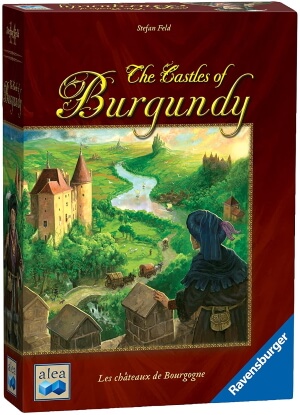
The Castles of Burgundy at a Glance
| Game Type Medieval Theme, Territory Building, Dice Rolling, Hexagon Grid, Tile Placement | Play Time 30 - 90 mins + | Skill/Complexity (3 - 5) Light to Medium Great Strategy Intro Game |
| Age 12+ | Publisher(s) Ravensburger | Published 2011 |
| Categories Strategy | Players 2 - 4 (2 - 3 is Ideal) | Manual Official Rules PDF |
| Our Rating 9/10 | Cost approx $34.99 |
In The Castles of Burgundy, players attempt to gain the most points by building up a province on their personal player board. At the beginning of a round, players roll 2 dice which they use to perform actions – drafting tiles to their supply, placing tiles from their supply onto their player board, and selling goods, to name a few. This game is typical of Stefan Feld’s games in the sense that players earn points for a wide range of actions and accomplishments, which I often argue leads to increased player engagement even if it means a hyper inflation of points. Naturally, players are drawn into a game when they feel they are constantly rewarded rather than punished.
In The Castles of Burgundy, players attempt to gain the most points by building up a province on their personal player board. At the beginning of a round, players roll 2 dice which they use to perform actions……..
This game plays particularly well at the 2P count because of the game’s scalability and low downtime. In a 2P game, fewer tiles become available each round in the public area to draft, and the rounds naturally move much quicker with fewer actions taking place with fewer players. Because the game has largely a “multi-player solitaire” feel, save for the occasional drafting of tiles to spite your opponent, the game doesn’t feel like it loses much with only 2P. In fact, a 2P game can last about an hour compare to 2+ hours with 4P.
All in all, The Castles of Burgundy is a solid classic game that everyone should play at least once to see if it is their style of game, and especially for people looking for a medium-weight Euro game that plays well with only 2P.
2. Le Havre – Best Economic Game
Heavy Euro-style games often get a bad reputation for having an insane learning curve that makes the games difficult to teach and get other players into. Very few heavy games truly master the art of having a simple ruleset and a well-crafted game arc in which players’ turns begin with simple decisions and progress into extremely challenging ones; in other words, the game’s heaviness is less in its rules overhead and more in its strategic planning and player efficiency. One game that has managed to do this very well is Le Havre, designed by Uwe Rosenberg.
Very few heavy games truly master the art of having a simple ruleset and a well-crafted game arc in which players’ turns begin with simple decisions and progress into extremely challenging ones……….
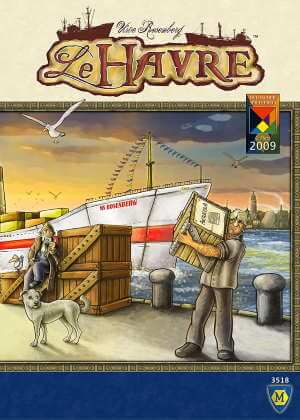
Le Havre at a Glance
| Game Type Nautical Theme, City Building, Economic, Automatic Resource Growth, End Game Bonuses, Loans, Ownership, Solo/Solitaire, Worker Placement | Play Time 30 - 150 mins | Skill/Complexity (4 - 5) Heavy |
| Age 12+ | Publisher(s) Mayfair Games and Others | Published 2008 |
| Categories Strategy | Players 1 - 5 | Cost $49.99 |
| Our Rating 8.9/10 |
When many gamers hear the name Uwe Rosenberg, they usually think large sprawling boards with piles of resources and thousands of decisions one can make on a turn and a rulebook that is not exactly easy to teach to new players. Le Havre is one of Mr. Rosenberg’s games, however, that sharply diverges from this norm by being a game that is especially easy to teach to new players with very simple rules – move your ship, and then pick up a pile of resources or move your worker to a building to execute its action.
Yet, within this simple ruleset comes a very complex decision space in what turns out to be a decently-heavy economic game. Over the course of the game, players must create an efficient economy to complete their end-game objective of creating the most wealth through buildings and ships. As the game progresses, more buildings become available which leads to more and more interesting and complicated decisions.
Le Havre isn’t a game that you don’t have to teach all at once. You can start as simple as you’d like and then add in details as new cards come out. And what makes Le Havre especially good with 2P is the fact that adding more players simply adds more time to the game but gives players fewer turns in each round. While the food requirement is less for more players, the game can still feel difficult to achieve your desired goals with more players. According to BoardGameGeek, about 1/3 of users believe that Le Havre is best with 2 players, and you should definitely give it a try!
3. Grand Austria Hotel – Best Dice-Drafting Game
There are very few multiplayer Euro-games that I can think of where I often hear people say, “I will only play that game with 2 players,” but the one that breaks this rule of thumb is Grand Austria Hotel, designed by Vigrinio Gigli and Simone Luciani.
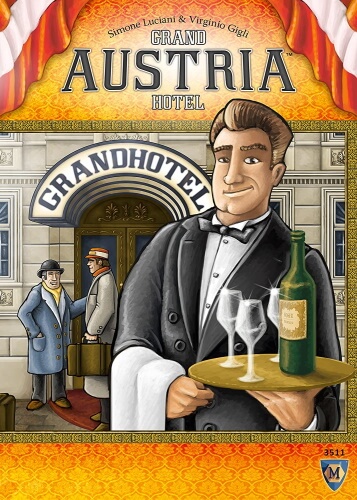
Grand Austria Hotel at a Glance
| Game Type Action Drafting, Auction: Dutch Contracts, Dice Rolling, End Game Bonuses, Once-Per-Game Abilities, Set Collection, Variable Player Powers, Variable Set-up | Play Time 60 - 120 mins | Skill/Complexity (3.3 - 5) Medium - Heavy |
| Age 12+ | Publisher(s) Lookout Games and Others | Published 2015 |
| Categories Strategy | Players 2 - 4 (2 Ideal ) | Cost $39.99 approx. |
| Our Rating 8.6/10 |
Grand Austria Hotel is a game full of points and bonuses where players try to run the best hotel in 20th century Austria by getting guests fed and into clean hotel rooms. The game is centered around a dice-drafting mechanism where players will take turns selecting an action whose power is determined by the number of dice at that action spot.
Grand Austria Hotel is a game full of points and bonuses where players try to run the best hotel in 20th century Austria by getting guests fed and into clean hotel rooms.
Players will get guests who will start out in their restaurant and will require various combinations of food, coffee, wine, and strudel. They will also try to get rooms ready and get guests into those rooms once they’ve been fed at the restaurant. Once guests check into rooms, players gain bonuses, and once all rooms in a certain area of the hotel are filled, players gain additional bonuses. There are also bonus objectives players try to fulfill as well as an emperor track that can either give players something good or bad depending on how far they’ve advanced at certain points in the game.
What makes Grand Austria Hotel a solid game at the 2P count is the fact that turn order is snake-based; in other words, players will get 2 turns in each round, with the starting player going first and last. In a 3 or 4 player game, this can lead to a significant amount of downtime between turns. There are elements of the game that feel similar to a game earlier on this list, The Castles of Burgundy, and if you are a fan of that game, this is definitely one you should check out.
4. Carcassonne – Best Family Game
Carcassonne is truly an evergreen modern classic family board game – after all, this is where the term “meeple” was born, and it continues to be a game that people enjoy getting to the table, and one I myself keep coming back to after having it in my collection for so many years. It’s full of expansion content to keep the game feeling fresh, and it’s very easy to teach and understand. It can have either a relaxing feel or can be very cutthroat depending on how players decide to play the game, and is a solid family game that everyone should try at least once.
Carcassonne is truly an evergreen modern classic family board game – after all, this is where the term “meeple” was born, and it continues to be a game that people enjoy getting to the table………
Carcassonne at a Glance
| Game Type Tile Placement City and Territory Building Medieval Theme | Play Time 45 mins | Skill/Complexity (2 - 5) Light |
| Age 8+ | Publisher(s) Hans im Glück and others | Published 2000 |
| Categories Family / 2 Player | Players 2 - 5 | Rules Manual Official Rules PDF |
| Our Rating 9.5/10 | Cost $24.99 + |
In Carcassonne, players take turns drawing tiles to place onto the table and connect to other tiles already in play. Together, players build a map consisting of cities, roads, monasteries, and fields, but only one player will be the winner by scoring points for claiming structures when they place tiles.
If a player wishes to claim a structure (i.e., city, road, monastery, or field), they place one of their available meeples on that structure, thereby preventing other players from claiming it. When a player completes a structure, they get their meeple back and gain points depending on the type of structure completed. The game ends once all tiles have been placed, and then players gain points for incomplete structures. The the player with the most points is the winner of the game.
Carcassonne is a good game at all player counts (up to 5 with the base game, but I probably wouldn’t want to play with more than that even though expansions add additional players). However, Carcassonne is an excellent 2P game because of the fact that you have more opportunity to build more structures and gain more points, and turns just seem to go faster with the quick back-and-forth that you get with 2P. It is also great with 5P, but the game can go by fast before you realize that you weren’t able to complete that extra-big city you were trying to build.
5. Glass Road – Best Resource-Management Game
Being the 2nd game on this list by Uwe Rosenberg, it’s obvious that many of his games provide a great 2P experience. One of his titles that really stands out as a multiplayer game that is excellent with 2 is Glass Road (yes, Fields of Arle is technically a 3-player game with the expansion, but I am counting that one as a 2-player-only game for this list). If you enjoy resource-management games with a puzzly twist, Glass Road will likely provide you with a great time.
If you enjoy resource-management games with a puzzly twist, Glass Road will likely provide you with a great time.
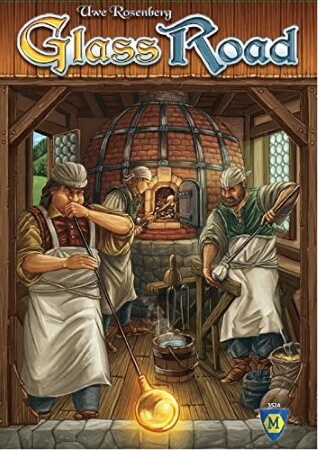
| Game Type City Building, Economic, Medieval, Card Drafting, Tile Placement | Play Time 20 - 80 mins | Skill/Complexity (3 - 5) Medium |
| Age 13+ | Publisher(s) Mayfair and Others | Published 2013 |
| Categories Strategy | Players 1 - 4 | Cost $59.99 approx |
| Our Rating 8.2/10 |
In Glass Road, players are trying to manage a glass and brick production business in the Bavarian Forest. Players try to gain the most points by clearing forests and adding buildings to their board that either provide one-time bonuses, ongoing abilities, or end-game scoring points. In a 2P game, players take turns playing cards from their hand that let them gain resources or perform certain actions like building buildings or clearing forests. Each card has two actions, and the trick is that if a player plays a card that the other player has left in their hand, that other player must also play that card but they will only be able to choose one of the actions on their card, while the player who revealed it will get to perform both.
What makes Glass Road stand out from other resource-management games is the unique resource wheels with dials. Each player has a glass wheel and a brick wheel, and when players move up their resource tokens, the dial can move and automatically generate either glass or brick. While this is ultimately what players are trying to do, it creates an interesting challenge when you are trying to decide which resource tokens to move up. If there is one resource holding back the dial from moving forward, a player might choose to not increase that resource so that they don’t automatically spend their other resources when they needed them to build a particular building.
The aspect of Glass Road that makes it great with 2P is the fact that in a multi-player game, players play their cards all face down and take turns flipping them over, whereas in a 2-player game, players play cards one by one face-up in front of them. This creates an interesting back-and-forth feel to the game and really trying to outguess your opponent. In a multi-player game, it can be challenging to really keep track of what your opponents are doing. It’s probably for this reason that the game is rated best with 2 players in the BoardGameGeek community.
6. Five Tribes – Best Mancala-Style Game
Five Tribes is a very divisive game – for some people, this game is a top 10 game; for others, it’s a game they would like to see burned. The problem that many people have with the game is the fact that it can be prone to analysis paralysis (AP), and, because the game board can change dramatically between turns, you can’t always plan what you are going to do while other players are taking their turns. These problems are largely solved by scaling the game back to 2P, and this is definitely an excellent game that you should give a look if you enjoy thinky Euros.
Five Tribes is a very divisive game – for some people, this game is a top 10 game; for others, it’s a game they would like to see burned.
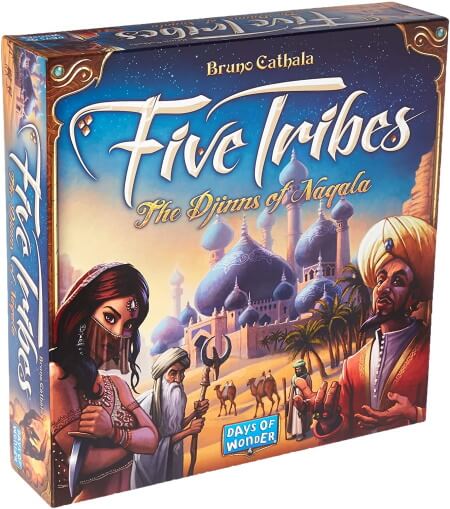
Five Tribes at a Glance
| Game Type Animals and Arabian Theme, Fantasy, Mythology, Auction/Bidding, Constrained Bidding, End Game Bonuses Hidden Victory Points, Mancala, Modular Board, Set Collection, Square Grid, Take That, Turn Order: Auction, Variable Player Powers, Variable Set-up, Victory Points as a Resource | Play Time 40 - 80 mins | Skill/Complexity (2.8 - 5) Medium |
| Age 13+ | Publisher(s) Days of Wonder and Others | Published 2014 |
| Categories Strategy | Players 2 - 4 (2 Ideal ) | Cost $64.99 approx. |
| Our Rating 8.5/10 |
Five Tribes is a game where players try to score the most points by moving a bunch of beautifully-colored meeples all around the game board in order to unlock actions and bonuses. It has a mancala mechanism that feels similar to one of my favorite games of all time, Trajan, and if you are a fan of Stefan Feld games, there is absolutely a lot to discover and enjoy about Five Tribes.
Each round begins with players auctioning for player order by spending coins. Coins represent VP in the game, meaning that players auction points to decide how important it is to go first. One thing that makes Five Tribes wonderful with 2P is the fact that each player has 2 pawns and will auction for turn 1, 2, 3, and 4, meaning that a player could go twice in a row in one round, or 4 times in a row over 2 rounds (if they go 3rd and 4th in the current round, and then go 1st and 2nd in the next). Going multiple times in a row can lead to some very satisfying turns and bonuses.
On a player’s turn, they pick one tile on the board. They pick up all the meeple on that tile, and then pick a tile to land on by dropping off meeple along the way. For example, if they pick up 4 meeple, they can pick a tile 4 tiles away, and drop off 3 meeple along the way. They will then pick up all the meeple of matching color on the tile where they ended their turn, perform the action based on that color, and then perform the bonus on that tile (such as placing palm trees or palaces, which provide points at the end of the game).
While there are a lot of actions and bonuses to describe, the main gist of the game is that players will get points for a whole load of things, and as the game progresses, it becomes an extremely thinky puzzle of where to move pieces to set up yourself for the next turn. It’s for this reason that it can certainly be AP-inducing, but with only 2P, this can feel much more manageable. Also, the fact that players can more often take 2-4 turns in a row means that they can actually plan things out more rather than dealing with the chaos of the ever-evolving state of the game board.
7. Race for the Galaxy – Best Engine-Building Card Game
I remember when I was first getting into the hobby, I was at a table with a very experienced gamer. I asked him, “If there is only one game you could keep in your collection and play for the rest of your life, what would it be?” His answer: Race for the Galaxy. When I asked why, he replied, “It takes about 20 times playing the game to even begin to grasp its depth, and even in the base game alone, there is so much strategy to explore.”
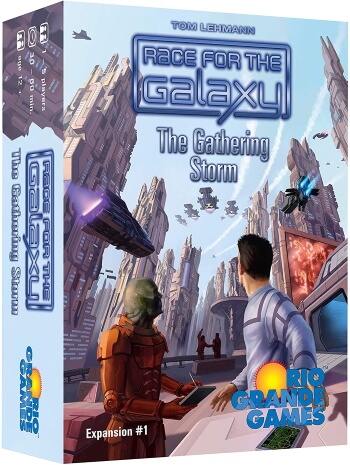
| Game Type Expansion for Base Game, Card Game, Civilization, Economic, Science Fiction, Simultaneous Action Selection, Variable Phase Order, Variable Player Powers | Play Time 60 mins | Skill/Complexity (3 - 5) Medium |
| Age 12+ | Publisher(s) Rio Grande Games and Others | Published 2008 |
| Categories Strategy | Players 1 - 5 | Cost $24.95 approx |
| Our Rating 8.7/10 |
When I finally got a chance to play this 20-minute engine-building card game, I quickly discovered what he was talking about. The first time I played it, I was incredibly intimidated and had absolutely no idea what was going on, even though I understood the rules. The iconography learning curve was steep, and even though I had played its sister game, San Juan, and understood the main mechanism concepts of the game, I felt like there was so much going on above my head that I needed to jump back in and play again…and again…and again.
So why did this game end up on a list of best multi-player games that plays best with 2? Well, in each round, players will each secretly select an action from their hand, and then reveal them. Each action that was selected will be triggered and all players will have a chance to perform that action, with the player who selected it gaining an additional bonus. In a 2P game, players can each select 2 actions, meaning that on any given round you are guaranteed to trigger at least 2 actions that are beneficial to you.
Over the course of the game, players place cards in to their tableau, which provide ongoing bonuses and end-game points. In a 2P game, the rounds move extremely fast, and it’s a lot easier to watch what your opponent is doing. This is also a game that would reward repeated plays with the same person over and over again as you learn each other’s strategies and try to outsmart your opponent. While Race for the Galaxy isn’t a game I would want to teach every time I play it, it’s just about the perfect strategy card game that plays well with 2P, and one I will always gladly play with someone who already knows the game.
8. Azul – Best Abstract Strategy Game
This entry on this list comes with one big caveat – if you enjoy a cutthroat 2-player gaming experience, this game is for you. If you don’t, this game might not be your best choice. With that out of the way, let’s take a quick look at why I enjoy Azul as a 2P abstract strategy tile-drafting/tile-placement game.
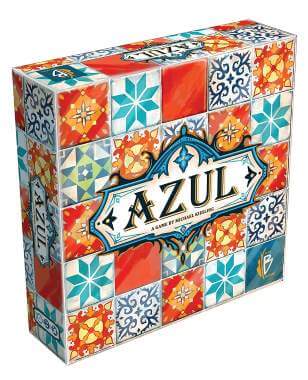
Azul at a Glance
| Game Type Renaissance Theme Abstract Card Drafting Pattern Building Tile Placement | Play Time 30 - 45 mins | Skill/Complexity (2.5 - 5) Good Medium - Light Abstract Strategy |
| Age 8+ | Publisher(s) Plan B Games and Others | Published 2017 |
| Categories Family / Teens / Abstract Strategy | Players 2 - 4 | Manual EN-Azul-Rules PDF |
| Our Rating 9.5/10 | Cost Approx $29.99 |
Azul, designed by Michael Kiesling, has simple rules, engaging gameplay, beautiful components, and enough depth to make many heavy gamers enjoy the game. In Azul, you are trying to get the most points by filling in a mosaic on your personal player board with different-colored tiles. When you place a tile, you get points for each tile in the same row and column, and at the end of the game, you get additional points for things like completed rows, columns, and completed colors.
Azul, designed by Michael Kiesling, has simple rules, engaging gameplay, beautiful components, and enough depth to make many heavy gamers enjoy the game.
At the beginning of each round, a number of discs (depending on player count) are seeded with 4 tiles from a bag, and the starting player token goes in the middle of the table. On a player’s turn, they select a disc and pick up all the tiles of one color on that disc. They then place those tiles in an available row on their board. The tiles that they didn’t pick go into the middle of the table. As an alternative on a player’s turn, they can select all of one color from the middle of the table, but they also gain the first player token if they are the first player to do so. The starting player token goes onto the bottom row of their board, which gives players negative points.
If a player decides, or is forced, to pick up tiles and does not have enough space in a row to place legally place them, the remaining tiles drop to the bottom row of their board and provide negative points. This is why the game becomes particularly tense with only 2 players, because there seems to be a lot more strategy in terms of picking tiles to force your opponent to take a lot of tiles that they can’t place in order to get negative points. There are many rounds where there might be a lot of one color in the middle of the board, and the two players will play chicken until the end of the round when one player is forced to take them all and lose a ton of points.
Azul can feel pretty relaxing with 3 or 4 players, but for some reason with 2P it can be aggravating, but in a good way if you enjoy that type of experience. If you are willing and able to laugh at yourself when your opponent forces you into a situation where you end up losing a ton of points, you will probably find Azul to be a great time.
9. Arboretum – Best Hand-Management Card Game
Azul leads perfectly into Arboretum, because this is also a game that can feel much more confrontational with only 2P in what deceptively seems like a relaxing and beautiful game. After all, Arboretum is all about building the most beautiful collection of trees of all sorts of colors. How could a game that looks like this possibly cause me so much stress, yet so much excitement?
After all, Arboretum is all about building the most beautiful collection of trees of all sorts of colors.
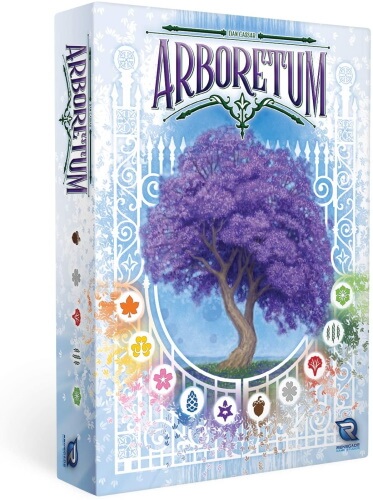
Arboretum at a Glance
| Game Type Bluffing, Card Game, Hand Management, Pattern Building, Set Collection, Tile Placement | Play Time 30 mins | Skill/Complexity (2.2 - 5) Light - Medium |
| Age 8+ | Publisher(s) Renegade Game Studios and Others | Published 2015 |
| Categories Family / Strategy | Players 2 - 4 (2 Ideal ) | Cost $21.99 approx. |
| Our Rating 8.3/10 |
In Arboretum, players take turns drafting 2 tree cards into their hand from any player’s face-up discard pile or a face-down draw pile, playing a card from their hand into their arboretum tableau, and then discarding 1 card from their hand into their discard pile.
Simple, right? Well, maybe not so much. You see, Arboretum is difficult to define. It feels like a tile-placement game, where players can place cards orthogonally adjacent to any card they’ve already placed, but how they place them is extremely important. I would say that at its core, Arboretum could best be defined as a hand-management card game, despite the fact that the cards on the table in front of you are what actually score you points.
Each card has a value of 1-8, and players will gain points for each type of tree by looking for the lowest-valued card of that type, and the highest-valued card of that type, and then counting the number of cards in ascending order in between (of any type). Player’s will gain 1 point for each card in their path, 1 additional point if their path is at least 4 cards long, 1 additional point if their path starts with a 1, and 1 additional point if their card ends with an 8. If this doesn’t already sound like enough to make your brain explode, buckle up.
Where the hand-management comes into play is given the fact that players can only score a path of a given tree type (of which there are 6 in a 2P game) if they gain the right to do so. In order to be able to score a path, a player must have highest sum of cards in their hand of that tree type. Furthermore, if a player has a value 8 in their hand and their opponent has a value 1, the value 8 becomes a value 0.
All of this to say, Arboretum is an extremely difficult and merciless puzzle of hand management. It’s a delicate balance between trying to play cards from your hand in order to make an excellent path to score a bunch of points and actually having the right cards in your hand in order to be able to score that tree type. Without the cards in your hand, your paths are worth absolutely nothing. Even more, you want to deny your opponent the ability to score their best paths by hoarding cards in your hand that do you no good but will hopefully give you the majority at the end of the game.
While Arboretum is good with 3 or 4 players, I think it really shines with 2, especially because it gives you the opportunity to get in your opponent’s head and figure out how you can really wreck their plans to get yourself ahead. As an added bonus, Arboretum has the best tie-breaking conditions I have ever seen in a game. It’s never happened to me, but I can’t wait until the day it does:
“In the case of a tie, the tied player with the most species present in their arboretum wins. If there is still a tie, the tied players much each plant a tree. In five years’ time, the player whose tree has grown the tallest wins.”
10. Exit: The Game Series – Best Puzzle Game
Escape-room-style games have become very popular in recent years, and one of the most popular line of games is Exit: The Game, designed by the famous duo Markus & Inka Brand. On the box, these games state that they play up to 4 players, and while I wouldn’t turn down a 4P Exit game, I would likely want to play with 2P if given the choice.

The Exit: The Game series are inexpensive one-time-use games where players will go through a story and attempt to solve mysteries and puzzles along the way. After playing through once, the games are not replayable as often times players will have to physically alter, destroy, or draw upon items included in the box. While many people might not like the idea of having to toss out a game after only playing it once, they are quite fun and are very affordable for a quiet night in when compared to the cost of going out to a movie or an escape room in person.
The Exit: The Game series are inexpensive one-time-use games where players will go through a story and attempt to solve mysteries and puzzles along the way.
While we can’t necessarily spoil any of the currently-available games in this Exit: The Game series, they all work very well with 2P because of the fact that the puzzles seem designed to be solved either solo or with the help of another person, and with 4P, there might not be a lot for each person to do at any given point in the game. The puzzles are often small, and having 4 people crowded around just doesn’t seem as enjoyable as sitting down with 1 other person and talking things through.
If you are looking for a fun puzzle to solve with another person, you can’t go wrong with any titles in the Exit: The Game series.
– That’s about it for the Multiplayer Games that are Especially Great with 2 Players category for now! We do an annual review of these to see what additions could be worth adding and any removals for better games.
Related – Don’t forget to check out the best 2 player board games that are designed solely for two players.
